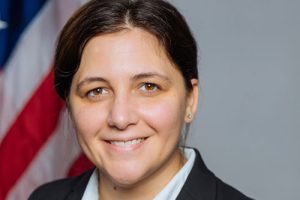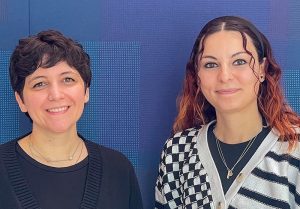Victory in 2024 DOJ Data Challenge Validates Career Move
Published December 19, 2024
 Jess Spayd is always up for a challenge.
Jess Spayd is always up for a challenge.
Having put her undergraduate and graduate degrees from the College of New Jersey – specifically psychology and counseling – to beneficial use through stints in private practice and school counseling, Spayd made the difficult decision to change career paths in 2021.
“I did some data work in my previous counseling roles, and I liked it,” Spayd said. “I liked the spreadsheets and the research, and I decided to move in that direction.”
After researching numerous programs, she decided to enroll in Johns Hopkins University’s MS in Data Analytics and Policy program. This bold professional pivot, which she completed in 2023, has paid off.
Spayd has spent the past 15 months as a data scientist in the U.S. Digital Corps at the U.S. General Services Administration. Her placement by USDC at the Health Resources and Services Administration now has her supporting data modernization efforts.
It was through her work at HRSA that Spayd met like-minded Bailey Sutton, with whom she works collaboratively on data analytics projects. When the pair learned of the 2024 Department of Justice Data Challenge, they were all in.
The 2024 contest required participants to analyze open datasets to better inform the Nation’s safety response to help solve the opioid crisis. The subject resonated with both Spayd and Sutton, who also shared an enthusiasm for R programming, and they decided to work in tandem on the challenge.
After submitting an initial two-page executive proposal in April, the duo dove into data over the next several months. Following selection notification of their proposal for phase two in May, and the acceptance of their initial proposal two weeks later, they submitted their final report in July and advanced to the finalist forum two weeks later. Spayd and Sutton presented their findings to the contest judges in August. They received declaration that they were the contest winners the next day. The DOJ shared the news of their victory on its social media channels on August 31- International Overdose Awareness Day.

In preparing their final report, Spayd and Sutton primarily used the National Forensic Laboratory Information System, a public data set that provides numbers on drugs seized by law enforcement and submitted to and analyzed by national forensic laboratories. They also made use of the Uniform Data System that includes data recovered by federally qualified health centers about their patient population and the services provided through health centers that receive federal funding. They called in data from the National Center for Health Statistics Underlying Cause of Death dataset, which includes overdose death reports, and finally they reviewed the U.S. Census Bureau’s American Community Survey that includes social, economic, and demographic variables that they used for controls in their study. The pair painstakingly reviewed all data, dating back to 2017 and extracted from national datasets across all 50 states and the District of Columbia.
“We had a lot of data, so preparing the data for analysis was the most challenging part,” Spayd said. “It took a lot of time to clean the data, to get it into the format required to conduct the analysis, but the data cleaning is actually a part of data science that I really enjoy.”
Spayd’s and Sutton’s findings verified that community measures, such as the NFLIS drug dataset, have the potential to better illustrate the impact of opioid use when compared with data on overdose deaths. The pair’s presentation also highlighted opportunities for public health and public safety organizations to better partner on both overdose prevention to save lives and on ways of addressing the overdose crisis through a national lens to better serve the American public.
“Participating in, and ultimately winning, this challenge was personally rewarding, especially because I did it with Bailey, who is very passionate and extraordinarily strong technically. She has been a great support for me in my role at HRSA, as both a peer and a mentor. We were prepared and confident about our data, and it was exciting to give a 20-minute presentation to a distinguished panel of judges that included the Chief Information Officer from the DOJ, the Chief Data Officer from the DEA, and the Chief Data Officer from the FBI. These were pretty important folks who really know data. They gave us really positive feedback, especially about the impact of our findings and our confirmation that cross agency datasets could present new findings to help the government strengthen and prioritize its overdose awareness and prevention efforts.”
In celebrating the victory, Spayd pointed to the excellent preparation that she received at Johns Hopkins through her Database Management Systems coursework, her Text as Data course, in particular her Quantitative Methods course from which she referenced her class notes to help her decide which statistical methods and metrics to incorporate in her contest submission.
As for Spayd’s next challenge, her current work has sparked an interest in data engineering, which supports data science and analytics, and she has not ruled out another foray into a specialization.
“The reason I made the pivot into data analytics was to be able to have a greater impact,” Spayd said. “One of the great things about working at the U.S. Digital Corps is that it pairs us with projects that are intentionally going to have a big and broad impact. That’s what really drives me. I enjoy the day-to-day technical work that I am doing. I want to continue to support health equity in my work, and I look forward to continued work in public service. I am really happy with the career change that I have made. I still feel I am having as much of an impact as I was in counseling, if not more.”
Attention: Students and Alumni
Are you a current AAP student or alumni and want to share your accomplishments?
Interested in pursuing a graduate degree at Johns Hopkins University?
Request information to learn more or apply here.